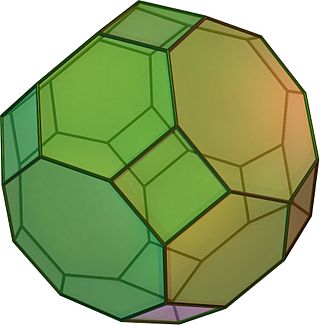| Truncated cuboctahedron | |
|---|---|
 (Click here for rotating model) | |
| Type | Archimedean solid Uniform polyhedron |
| Elements | F = 26, E = 72, V = 48 (χ = 2) |
| Faces by sides | 12{4}+8{6}+6{8} |
| Conway notation | bC or taC |
| Schläfli symbols | tr{4,3} or |
| t0,1,2{4,3} | |
| Wythoff symbol | 2 3 4 | |
| Coxeter diagram | |
| Symmetry group | Oh, B3, [4,3], (*432), order 48 |
| Rotation group | O, [4,3]+, (432), order 24 |
| Dihedral angle | |
| References | U11, C23, W15 |
| Properties | Semiregular convex zonohedron |
 Colored faces |
 4.6.8 (Vertex figure) |
 Disdyakis dodecahedron (dual polyhedron) |
 Net |
In geometry, the truncated cuboctahedron or great rhombicuboctahedron is an Archimedean solid, named by Kepler as a truncation of a cuboctahedron. It has 12 square faces, 8 regular hexagonal faces, 6 regular octagonal faces, 48 vertices, and 72 edges. Since each of its faces has point symmetry (equivalently, 180° rotational symmetry), the truncated cuboctahedron is a 9-zonohedron. The truncated cuboctahedron can tessellate with the octagonal prism.

![{\displaystyle {\begin{aligned}{\text{4-6:}}&\ \arccos {\tfrac {-{\sqrt {6}}}{3}}=144^{\circ }44'08''\\[4pt]{\text{4-8:}}&\ \arccos {\tfrac {-1}{\sqrt {2}}}=135^{\circ }\\{\text{6-8:}}&\ \arccos {\tfrac {-{\sqrt {3}}}{3}}=125^{\circ }15'51''\end{aligned}}}](https://wikimedia.org/api/rest_v1/media/math/render/svg/ad2edada83ede0261a61223952aa4e01f01d5b09)